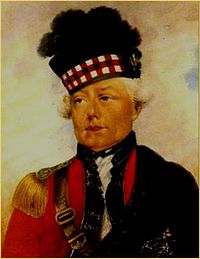- John Small (British Army officer)
-
John Small 
Major General John SmallBorn 1726
Strathardle, AtholeDied 17 March 1796
Guernsey, EnglandBuried at Guernsey, England Allegiance  United Kingdom
United KingdomService/branch British Army Rank Major-General Battles/wars Seven Years' War
American Revolutionary WarMajor-General John Small (1726 – 17 March 1796) was a British military officer who was most famous for his leadership in the 84th Regiment of Foot (Royal Highland Emigrants) and his involvement in the Battle of Bunker Hill.
Contents
Seven Years War
In 1756, Major Small served in the 42nd Regiment of Foot in the Seven Years War. He was involved in the Oswego, Montreal, Battle of Ticonderoga (1758), and West Indies campaigns.
In 1762, Major Small was promoted to captain. In 1765, he was appointed to a company of the 21st Regiment of Foot.
American Revolution
Small served with the 21st in America until 1775 when he received an unofficial commission from General Gage to raise the Young Royal Highlanders at his own expense which was later amalgamated into the Royal Highland Emigrants (84th Regiment of Foot). Small spent the greatest part of his time in New York on staff duty.
Battle of Bunker Hill, Boston
Major John Small was engaged to establish the Royal Highland Emigrants on 13 June 1775. About a week later, Small and a number of other members of the Regiment were in the Battle of Bunker Hill, the first major battle of the American Revolution.[1]
Along with three other members of the 84th Regiment, Small was wounded in the arm by cannon fire.[2]
 John Trumbull's The Death of General Warren at the Battle of Bunker Hill
John Trumbull's The Death of General Warren at the Battle of Bunker Hill
John Small was instrumental in assisting John Trumbull with his famous painting The Death of General Warren at the Battle of Bunker Hill.[3] Major Small is at the centre of the action holding the bayonet to prevent a British soldier from killing his friend, American Patriot Joseph Warren (who was in reality shot through the head and instantly killed by a musket ball). The painting depicts the divisions the conflict created between people who were friends, yet were caught on opposite sides of the conflict. (Small also served with Israel Putnam, the colonial general at Bunker Hill, during the French and Indian War.)
84th Highland Regiment of Foot
Small was commander of the 84th Regiment of Foot (Royal Highland Emigrants), 2nd Battalion which eventually settled in the Douglas Township in Hants County, Nova Scotia. Small is reported to have built a manor house in Selma, Nova Scotia, called "Selmah Hall", after which the community is named.[4]
In 1794, he became Lieutenant Governor of Guernsey and promoted to major general.
References
Primary Texts
- Oxford Dictionary of National Biography
- Biography of Major Small by Kim Stacy
- Katcher, Philip, Encyclopaedia of British, Provincial, and German Army Units 1775-1783, 1973, ISBN 0811705420
Notes
- ^ Also participating in the Battle were other officers of the newly raised Royal Highland Emigrants (A.K.A.Young Royal Highlanders). With him were Captain Ranald MacDonald, Captain Alexander Campbell, Captain Donald McLeod (who was recovering from wounds taken at Lexington), Volunteer William Walker, Sergeant Allan MacArthur, and a small contingent of men.
- ^ The three others were Captain Ranald MacDonald, Captain Alexander Campbell, Captain Donald McLeod
- ^ See Trumbull's Letter dated March 30, 1818 in which he writes about his conversation with Major Small in London, 1786.
- ^ Duncanson, Two Loyalist Townships: Rawdon and Douglas
Government offices Preceded by
Sir James CraigLieutenant Governor of Guernsey
1793Succeeded by
Sir Hew DalrympleCategories:- 1726 births
- 1796 deaths
- History of Nova Scotia
Wikimedia Foundation. 2010.
